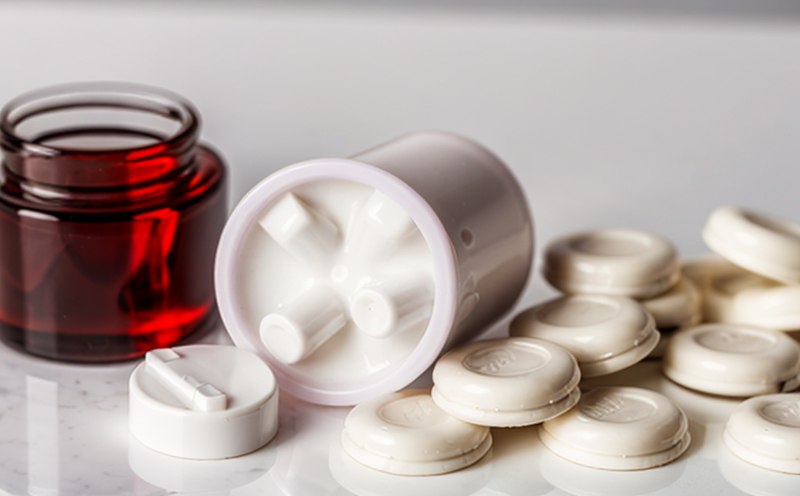USP Assay Testing of Capsules
The USP Assay Testing of Capsules is a critical component in ensuring the quality and consistency of oral solid dosage forms. This testing process adheres to United States Pharmacopeia (USP) standards, which are internationally recognized for their stringent requirements on drug product quality.
During this procedure, capsules are analyzed for active pharmaceutical ingredients (APIs), excipients, and other components that make up the final dosage form. The assay aims at quantifying these constituents to ensure they meet the prescribed specifications outlined in USP monographs. This testing is essential not only for compliance with regulatory authorities but also for maintaining product integrity and efficacy.
The process involves several steps: first, the capsule must be properly prepared by removing any coatings or contents that could interfere with accurate measurement of the API. Then, dissolution media appropriate to the type of capsule (e.g., water-soluble vs oil-based) is used. Once dissolved, the solution undergoes analysis using various analytical techniques such as High Performance Liquid Chromatography (HPLC), Infrared Spectroscopy (IR), or even Inductively Coupled Plasma Mass Spectrometry (ICP-MS).
The results obtained from these analyses are compared against established USP limits. Any deviation from the standard can indicate issues with formulation, manufacturing processes, or storage conditions. Proper assay testing helps identify potential discrepancies early on, allowing for corrective actions to be taken promptly.
For accurate results, it’s crucial to follow precise protocols and use reliable equipment calibrated according to national standards like those set forth by NIST (National Institute of Standards & Technology). Additionally, maintaining a clean lab environment free from contaminants ensures that the tests yield reproducible outcomes. By adhering strictly to these procedures, laboratories can provide assurance that their clients receive consistent and high-quality products.
Understanding how this testing impacts different stakeholders within pharmaceutical companies highlights its importance:
- Quality Managers: They rely on accurate assays to ensure product consistency and adherence to regulatory guidelines.
- Compliance Officers: Compliance with USP standards ensures that products meet legal requirements, avoiding potential recalls or fines.
- R&D Engineers: Assays contribute valuable data towards optimizing formulations and improving overall drug performance.
- Procurement: Reliable test results help in selecting reputable suppliers who consistently produce quality materials.
Why It Matters
The reliability and accuracy of USP Assay Testing are paramount in the pharmaceutical industry. Regulatory bodies worldwide demand compliance with these standards to ensure public safety and efficacy of medications. Non-compliance can lead to severe consequences, including product recalls, legal actions, and damage to brand reputation.
Consistent testing ensures that each batch of capsules produced meets established specifications, thereby safeguarding consumer health by preventing substandard or potentially harmful products from reaching the market. It also supports continuous improvement efforts within R&D departments, enabling them to refine formulations based on empirical evidence derived through rigorous testing procedures.
In addition, reliable assay results facilitate efficient supply chain management by providing assurance about material quality and consistency across different batches sourced from various suppliers. This transparency fosters trust between manufacturers and their partners, enhancing overall operational efficiency.
Benefits
- Enhanced Quality: Ensures that all capsules produced meet strict USP standards for active ingredients and excipients.
- Regulatory Compliance: Helps pharmaceutical companies adhere to international regulatory requirements, avoiding legal issues.
- Risk Reduction: Identifies potential quality issues early in the production process, minimizing risks associated with substandard products.
- Increased Efficiency: Streamlines supply chain operations by ensuring consistent material quality from suppliers.
Use Cases and Application Examples
| Case Study | Description | Outcome |
|---|---|---|
| Case 1: A multinational pharmaceutical company sought to enhance the quality control of its capsule line. By implementing USP Assay Testing, they were able to identify discrepancies in API content across multiple batches. | The lab conducted assays on various lots of capsules using HPLC and found that some batches contained more or less active ingredient than specified by USP standards. This led to immediate corrective actions including retraining staff on proper handling techniques and adjusting the production process parameters. | Following these adjustments, subsequent batches met all required specifications, significantly improving product quality and reducing the risk of non-compliance issues with regulatory authorities. |
| Case 2: An R&D team aimed to develop a new formulation for an oral solid dosage form. USP Assay Testing played a key role in validating their experimental batches before moving into clinical trials. | The tests revealed that certain excipients did not dissolve properly under the specified conditions, necessitating changes to the excipient mix. | By addressing these issues early on through thorough assay testing, the team was able to refine their formulation successfully, ultimately leading to a more effective and stable drug product. |





